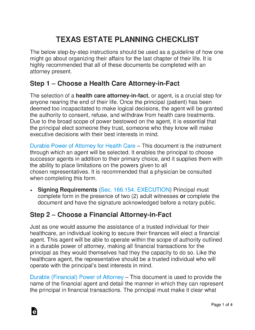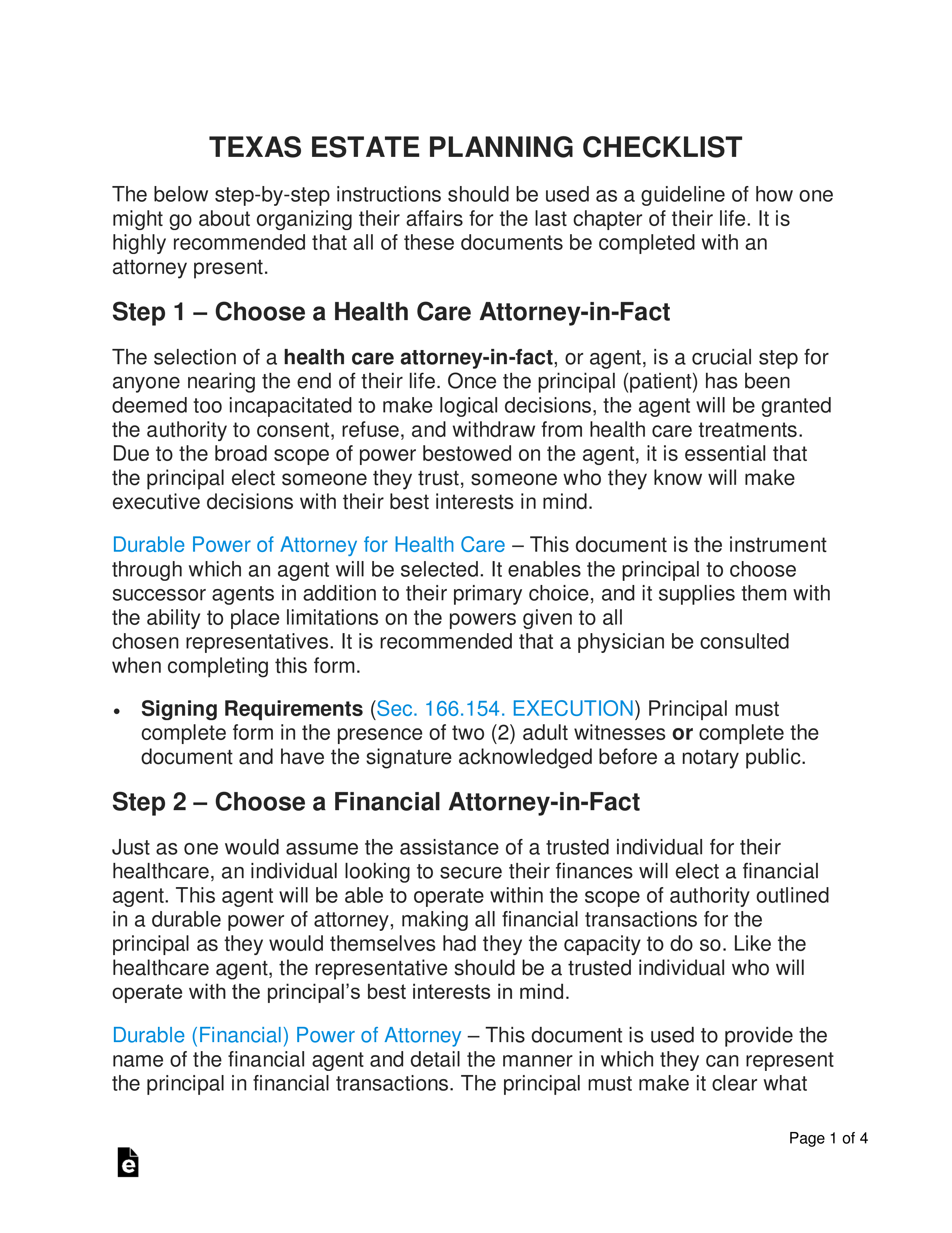Updated March 05, 2024
A Texas estate planning checklist is a guide created to assist Texas residents in planning for the distribution of their estate and election of healthcare and financial agents. When an individual approaches the end of their life, they are faced with critical decisions concerning how their estate will be managed should their health decline to such a point that they’re unable to care for themselves. A Durable (Financial) Power of Attorney can be drafted, enabling a trusted attorney-in-fact to attend to the principal’s finances. A Durable Power of Attorney for Health Care grants an agent the authority to make medical decisions on the behalf of the creator. A Last Will and Testament and/or a Revocable Living Trust can be used to divide an estate among beneficiaries following the estate owner’s death.
How to Create an Estate Plan in Texas (6 steps)
- Choose a Health Care Attorney-in-Fact
- Choose a Financial Attorney-in-Fact
- Prepare Current Assets List
- Identify Beneficiaries
- Draft a Living Trust/Last Will and Testament
- Storing the Documents
The below step-by-step instructions should be used as a guideline of how one might go about organizing their affairs for the last chapter of their life. It is highly recommended that all of these documents be completed with an attorney present.
1. Choose a Health Care Attorney-in-Fact
The selection of a health care attorney-in-fact, or agent, is a crucial step for anyone nearing the end of their life. Once the principal (patient) has been deemed too incapacitated to make logical decisions, the agent will be granted the authority to consent, refuse, and withdraw from health care treatments. Due to the broad scope of power bestowed on the agent, it is essential that the principal elect someone they trust, someone who they know will make executive decisions with their best interests in mind.
Durable Power of Attorney for Health Care – This document is the instrument through which an agent will be selected. It enables the principal to choose successor agents in addition to their primary choice, and it supplies them with the ability to place limitations on the powers given to all chosen representatives. It is recommended that a physician be consulted when completing this form.
- Signing Requirements – Principal must complete form in the presence of two (2) adult witnesses or complete the document and have the signature acknowledged before a notary public.[1]
2. Choose a Financial Attorney-in-Fact
Just as one would assume the assistance of a trusted individual for their healthcare, an individual looking to secure their finances will elect a financial agent. This agent will be able to operate within the scope of authority outlined in a durable power of attorney, making all financial transactions for the principal as they would themselves had they the capacity to do so. Like the healthcare agent, the representative should be a trusted individual who will operate with the principal’s best interests in mind.
Durable (Financial) Power of Attorney – This document is used to provide the name of the financial agent and detail the manner in which they can represent the principal in financial transactions. The principal must make it clear what transactions they authorize the agent to carry out as well as the effective date of the legal instrument.
- Signing Requirements – Must be signed by the principal and the signature acknowledged by a State official authorized to take oaths and acknowledgments.[2]
Financial Powers Allowed:
- Real property transactions;
- Tangible personal property transactions;
- Stock and bond transactions;
- Commodity and option transactions;
- Banking and other financial institution transactions;
- Business operating transactions;
- Insurance and annuity transactions;
- Estate, trust, and other beneficiary transactions;
- Claims and litigation;
- Personal and family maintenance;
- Benefits from social security, Medicare, Medicaid, or other governmental programs
- or civil or military service;
- Retirement plan transactions;
- Tax matters
3. Prepare Current Assets List
4. Identify Beneficiaries
5. Draft a Living Trust/Last Will and Testament
There are two (2) principal legal instruments used to communicate the deceased’s wishes for estate administration; a Last Will and Testament, and a Living Trust. It is not uncommon to use both or either of these documents as they are both functional tools in delivering assets and property to beneficiaries.
Last Will and Testament (‘Will’) – A Last Will and Testament is a document specifically designed to provide instructions on how an individual would like their estate to be handled following their death. For this reason, it is considered the most important component of any estate plan. Even if a Living Trust is employed to divide the majority of the estate, it is wise to include a Pour-Over Will to account for anything the testator may have forgotten. A Last Will and Testament must pass through probate before beneficiaries will receive their estate percentage.
- Signing Requirements – A Will must be signed by the Testator and two (2) witnesses of at least fourteen (14) years of age.[3]
Living Trust (Revocable) – A Revocable Living Trust is also an estate planning device; however, it differs in certain key aspects from a Will. The primary benefit is that the document will not have to pass through a lengthy probate process before the assets can be transferred to the name beneficiaries. Instead, an individual with the title of successor trustee (named within the document) will be responsible for administering the grantor’s (creator of trust) estate following their death. Another considerable difference is the fact that a Trust becomes effective immediately after the document has been signed, enabling the grantor to transfer ownership of their assets into the Trust while continuing to benefit from them during their lifetime.
- Signing Requirements – No statutorily enforced signing requirements for signing a Trust document.
6. Storing the Documents
Texas Estate Planning Laws
- Advance Directive – ADVANCE DIRECTIVE ACT
- Durable Power of Attorney – Title 2, Sec. 751. GENERAL PROVISIONS REGARDING DURABLE POWERS OF ATTORNEY
- Last Will and Testament – Title 2, Sec. 251 FUNDAMENTAL REQUIREMENTS AND PROVISIONS RELATING TO WILLS
- Living Trust (Revocable) – Title 9, Sec. 751 CREATION, VALIDITY, MODIFICATION, AND TERMINATION OF TRUSTS


